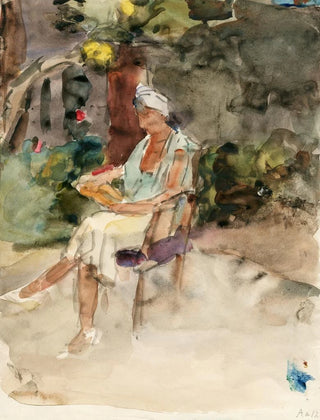Art print | Woman reading on a chair in a garden - Isaac Israëls


View from behind

Frame (optional)
Captivating introduction
In the vibrant world of Dutch painting, the artwork "Woman reading on a chair in a garden" by Isaac Israëls stands out for its delicacy and intimate atmosphere. This depiction of a woman absorbed in her reading evokes not only the tranquility of a suspended moment but also the fleeting beauty of the surrounding nature. The artist manages to capture the very essence of passing time, where every detail, from lush foliage to reflections of light, contributes to creating a scene filled with serenity. The composition invites the viewer to immerse themselves in this privileged moment, to share the quietude of this woman whose universe seems limited to the book she holds in her hands. The painting then becomes a portal to a silent world, where one can almost hear the rustling of leaves and the singing of birds.
Style and uniqueness of the work
Isaac Israëls' style is characterized by a soft and harmonious color palette, where shades of green and blue blend with touches of golden light. In "Woman reading on a chair in a garden," the artist uses natural light to accentuate contours and textures, creating an almost tangible atmosphere. Fluid brushstrokes and meticulous details testify to his skill in rendering life and movement. The woman's posture, both relaxed and focused, evokes a psychological depth that transcends the simple act of reading. Israëls manages to transform a mundane scene into a work of art, where each element is carefully orchestrated to evoke universal emotions. This painting, far from being a mere representation, becomes an invitation to contemplation, escape, and daydreaming.
The artist and his influence
Isaac Israëls, heir to a rich artistic tradition, has forged a unique identity within the Impressionist movement. Born in The Hague in 1865, he was influenced by masters such as Vincent van Gogh and Claude Monet, but also developed a distinctive style that is entirely his own. His work is often marked by scenes of everyday life, where he explores the

Matte finish

View from behind

Frame (optional)
Captivating introduction
In the vibrant world of Dutch painting, the artwork "Woman reading on a chair in a garden" by Isaac Israëls stands out for its delicacy and intimate atmosphere. This depiction of a woman absorbed in her reading evokes not only the tranquility of a suspended moment but also the fleeting beauty of the surrounding nature. The artist manages to capture the very essence of passing time, where every detail, from lush foliage to reflections of light, contributes to creating a scene filled with serenity. The composition invites the viewer to immerse themselves in this privileged moment, to share the quietude of this woman whose universe seems limited to the book she holds in her hands. The painting then becomes a portal to a silent world, where one can almost hear the rustling of leaves and the singing of birds.
Style and uniqueness of the work
Isaac Israëls' style is characterized by a soft and harmonious color palette, where shades of green and blue blend with touches of golden light. In "Woman reading on a chair in a garden," the artist uses natural light to accentuate contours and textures, creating an almost tangible atmosphere. Fluid brushstrokes and meticulous details testify to his skill in rendering life and movement. The woman's posture, both relaxed and focused, evokes a psychological depth that transcends the simple act of reading. Israëls manages to transform a mundane scene into a work of art, where each element is carefully orchestrated to evoke universal emotions. This painting, far from being a mere representation, becomes an invitation to contemplation, escape, and daydreaming.
The artist and his influence
Isaac Israëls, heir to a rich artistic tradition, has forged a unique identity within the Impressionist movement. Born in The Hague in 1865, he was influenced by masters such as Vincent van Gogh and Claude Monet, but also developed a distinctive style that is entirely his own. His work is often marked by scenes of everyday life, where he explores the






